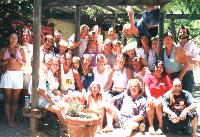Clearing the Air™ Workshops

|
|
|
|
|
|
|
|
 Healing the
Father Wound®
historical perspective
historical
Healing the
Father Wound®
historical perspective
historical
Gordon Clay created the Healing the Father Wound® workshop as listed in Ellen Lederman's, Vacations that can Change Your Life) in 1985 when he recognized the need for a workshop to address the wounding men and women experience around their father. Gordon has been actively working on issues around anger and how to appropriately release tension and blocked emotion since 1976. He designed the workshop with the mission to make the world safe for children. We carry safety within us, as we carry the ability to lose it.How do we insure our own safety and the safety of those around us? One way is to find where we have suffered abuse, and where we have been abusive. When we have found these places within ourselves we can heal them. We can thereby heal our relationships with friends, family and community.
The workshop has been lauded as the most effective anger workshop available. Practiced techniques of movement, Tantrum Yoga® breathwork and experiential exercises were used to access and release stored anger in a manner that is healthy and appropriate. Gordon Clay was the Facilitator of this 3 night, 4 day workshop for 12 men or 12 women on both coasts and retired the workshop in 2010. Watch for the release of a shortened version on CD.
Children's first impressions about men come from their early experiences with their perfect, present, abusive, distant or absent father. Regardless of parental devotion, no parent can fulfill all of the child's wants and desires. While these wounds can be inflicted with intent, many are unintentional and affect the child throughout life.
This relationship forms the daughter's opinions of what men are or should be, how they should act, especially towards her, and how she should be with them. The father's behavior towards women shapes the way she learns to relate to men as well as how she relates to her own masculine side. If the father withdrew his affection at the time she entered puberty, the wound was further impacted.
Did your father rob you of valuable lessons and positive masculine guidance by merely accepting the role of disciplinarian? Or did he teach and enforce appropriate boundaries and limits? Did he model how to give and receive affection and tenderness while demonstrating the proper use of strength and power?
Part of the father's unwritten responsibility is to lovingly prepare his daughter for the major shift that has taken place in her world as women enter the traditional "male" arena. Unfortunately, many father's, themselves, had trouble adjusting and many others just weren't available to teach her to venture out from the protected realm of the home to deal with this new world and its conflicts. They didn't teach decision making balanced with objectivity nor help her develop the skills necessary to work with authority.
This relationship forms the son's opinions of how he is supposed to act and how he should treat women. Too often, however, the father wasn't around to present a healthy model for his son.
Today, men have had to face the confusing challenge of learning to balance power with sensitivity, strength with feeling, and mind with heart all on their own.
Are you confused about your "role" today? Does it feel like you have to solve all of your problems on your own and hide the feelings of fear, pain or sadness (act like a man)? Are you still affected by past feelings or resentments toward your father?
We will learn to dissolve our own isolation by learning that all men have fear, pain and sadness. We will break down old barriers of competition and distrust to explore feelings and relationships and begin the healing process. We will use the strength that men bring to men to expand our knowledge and feelings without abandoning such traditional male virtues as courage, honor, loyalty and strength.
Blame is a festering wound which needs to be released. Letting go yet holding the father responsible for what he did or did not do is important medicine for the wound. Forgiving him allows the wound to scab over which leads to eventual healing. The scar then becomes the reminder that healing has taken place.
In a safe, supportive, non-shaming environment, conducive to major change, we utilized appropriate emotional release and experiential exercises to release many of the stuck feelings and hidden memories.
* * *
are registered trademarks of Gordon Clay ©1985-2025 Gordon Clay
